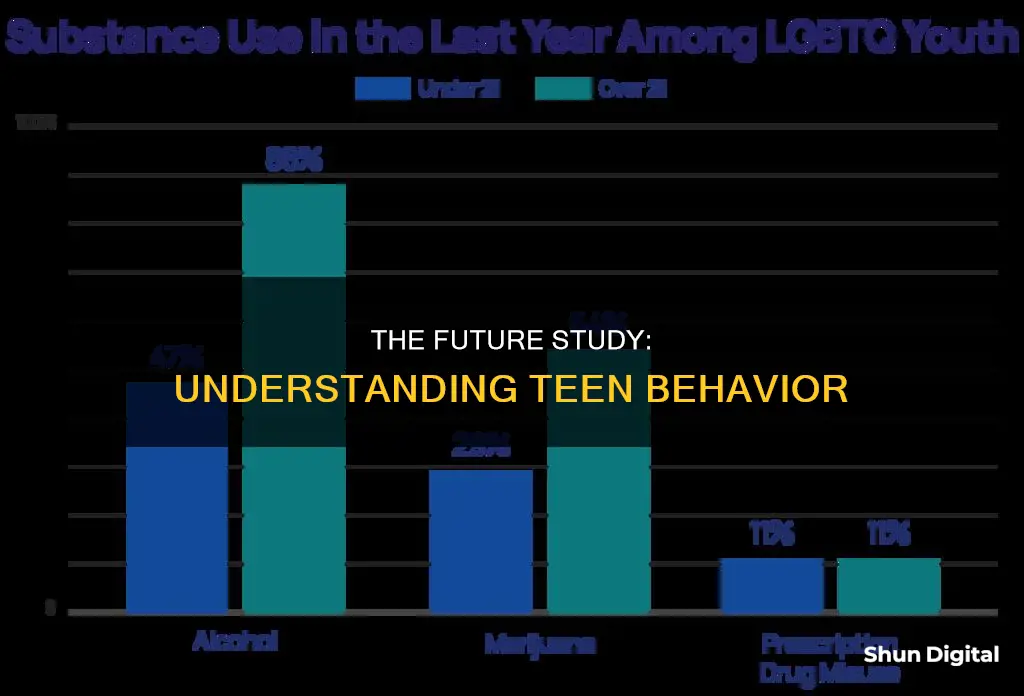
The Monitoring the Future (MTF) project is a long-term study that began in 1975. It aims to study changes in the beliefs, attitudes, and behaviors of young people in the United States. The focus is on youth because they are at the forefront of today's social changes and will shape future society. The study is conducted by the University of Michigan's Institute for Social Research and funded by the National Institute on Drug Abuse, a part of the National Institutes of Health. The MTF survey measures drug and alcohol use and related attitudes among American adolescents and adults, with a particular focus on trends in legal and illicit drug use. It also covers topics such as educational and occupational plans, gender roles, race and ethnicity, trust in institutions, environmental concerns, media consumption, and more.
| Characteristics | Values |
|---|---|
| Purpose | To study changes in the beliefs, attitudes, and behaviors of young people in the United States |
| Started | 1975 |
| Focus | Youth (8th, 10th, and 12th graders) and young adults |
| Frequency | Annually |
| Sample Size | 50,000 8th, 10th, and 12th graders |
| Topics Covered | Drug use, educational plans, gender roles, race/ethnicity, trust in government, environmental concerns, media consumption, victimization, delinquency, marriage, family formation, college attendance, military service, employment, and unemployment |
| Funding | National Institute on Drug Abuse, part of the National Institutes of Health |
| Conducted By | University of Michigan's Institute for Social Research |
| Data Availability | Data is made public while preserving confidentiality of respondents |
| Data Host | National Addiction & HIV Data Archive Program (NAHDAP) |
| Data Years Available | 1976-2023 |
What You'll Learn
- To study changes in beliefs, attitudes, and behaviours of young people in the United States
- To monitor progress toward national health goals
- To study trends in substance use and abuse among adolescents and young adults
- To understand the epidemiology and etiology of substance use and related behaviours
- To evaluate the impact of social changes on youth

To study changes in beliefs, attitudes, and behaviours of young people in the United States
The Monitoring the Future (MTF) project was started in 1975 to study changes in the beliefs, attitudes, and behaviours of young people in the United States. The study focuses on youth because they are significantly involved in today's social changes and will, quite literally, constitute our future society.
The MTF study has been conducted under a series of research grants from the National Institute on Drug Abuse, a part of the National Institutes of Health. The surveys have been carried out each year since 1975 by the University of Michigan Survey Research Center. The study initially focused on that year's senior class, but in 1991, it was expanded to include 8th and 10th graders. The MTF Main study, widely known for some years as the National High School Senior Survey, is a repeated series of surveys in which the same segments of the population (8th, 10th, and 12th graders; college students; and young adults) are presented with the same set of questions over a period of years to see how answers change over time.
The surveys explore changes in important values, behaviours, and lifestyle orientations of contemporary American youth. Students in each grade are randomly assigned to complete one of four questionnaires, each with a different subset of topical questions but containing a set of "core" questions on demographics and drug use. There are more than 500 variables across the questionnaires. Drugs covered by the survey include amphetamines (stimulants), barbiturates (tranquilizers), other prescription drugs, over-the-counter medications, tobacco, smokeless tobacco, vaping, alcohol, inhalants, steroids, marijuana, hashish, LSD, hallucinogens, cocaine, crack, ecstasy, methamphetamine, and injectable drugs such as heroin.
The MTF study also covers a variety of topics beyond drug use. These include subjects' occupational and educational plans and experiences, attitudes about gender roles, attitudes and experiences with people of a different race/ethnicity, trust in government and other institutions, concerns about the environment, media consumption, victimization and delinquency, among other things.
The results of the study are useful to policymakers at all levels of government, for example, to monitor progress toward national health goals. Study results are also used to monitor trends in substance use and abuse among adolescents and young adults and are used routinely in the White House Strategy on Drug Abuse.
IPS Display: How to Check Your Monitor's Panel Type
You may want to see also

To monitor progress toward national health goals
The Monitoring the Future (MTF) project has been ongoing since 1975, and one of its purposes is to monitor progress toward national health goals. The study focuses on youth because they are significantly involved in today's social changes and will constitute future society. The results of the study are useful to policymakers at all levels of government.
The MTF Main study, also known as the National High School Senior Survey, is a repeated series of surveys that present the same segments of the population (8th, 10th, and 12th graders; college students; and young adults) with the same set of questions over a period of years to see how answers change over time. The surveys explore changes in the values, behaviors, and lifestyle orientations of contemporary American youth. Each year, more than 25,000 8th, 10th, and 12th-grade students are surveyed as part of the MTF Main study.
The MTF Panel study extends the work of the MTF Main study by following a subsample of graduating seniors through their entire adult lives. This study provides needed insight into the epidemiology and etiology of substance use and related behaviors, attitudes, and other factors. The Panel study now has over 120,000 individuals up to age 65 who were first surveyed in 12th grade at age 18.
The surveys cover a range of topics, including drug and alcohol use, personal levels of perceived risk and disapproval for each drug, and attitudes and behaviors toward issues such as religion, parental influences, changing roles of women, educational aspirations, self-esteem, exposure to sex and drug education, and violence and crime.
The Monitoring the Future study is committed to making its data publicly available while also protecting and preserving the confidentiality of its respondents. The data is hosted at the National Addiction & HIV Data Archive Program (NAHDAP), which facilitates research on drug addiction and HIV infection.
Testing LCD Backlight: Quick Checks for Monitor Issues
You may want to see also

To study trends in substance use and abuse among adolescents and young adults
The Monitoring the Future (MTF) project, which began in 1975, has studied trends in substance use and abuse among adolescents and young adults in the United States. The study focuses on youth because of their significant involvement in today's social changes and because they will constitute future society. The results are useful to policymakers at all levels of government, helping to monitor progress toward national health goals and inform strategies on drug abuse.
The MTF Main study, also known as the National High School Senior Survey, is a repeated series of surveys that present the same segments of the population (8th, 10th, and 12th graders; college students; and young adults) with the same set of questions over a period of years to see how answers change over time. The study has been conducted under research grants from the National Institute on Drug Abuse, with surveys carried out each year by the University of Michigan Survey Research Center.
The MTF surveys explore changes in beliefs, attitudes, and behaviors related to substance use. This includes studying trends in the use of various substances, such as amphetamines, barbiturates, prescription drugs, tobacco, alcohol, inhalants, steroids, marijuana, hallucinogens, cocaine, and more. The surveys also gather information on respondents' perceived availability of drugs, norms among peer and role model groups, and personal levels of perceived risk and disapproval for each drug.
The MTF Panel study extends the work of the MTF Main study by following a subsample of graduating seniors through their adult life course. This provides valuable data on the epidemiology and etiology of substance use, as well as related behaviours, attitudes, and other factors. The Panel study surveys are conducted annually, with follow-up surveys every two years from ages 19-30 and every five years starting at age 35.
The MTF study is committed to making its data publicly available while also protecting the confidentiality of its respondents. The data is hosted at the National Addiction & HIV Data Archive Program (NAHDAP), which facilitates research on drug addiction and HIV infection. The MTF study provides important insights into the trends and factors influencing substance use among adolescents and young adults in the United States.
Hooking Up Raspberry Pi: Monitor Connection Guide
You may want to see also

To understand the epidemiology and etiology of substance use and related behaviours
The Monitoring the Future (MTF) project is a long-term epidemiological study that began in 1975. It focuses on understanding the epidemiology and etiology of substance use and related behaviours, attitudes, and other factors. The study has been conducted by the University of Michigan's Institute for Social Research and funded by research grants from the National Institute on Drug Abuse, a part of the National Institutes of Health.
The MTF study collects data from a large and diverse group of individuals over time, providing valuable insights into the epidemiology of substance use. The study follows a subsample of individuals from adolescence through adulthood, tracking their substance use patterns and related behaviours. This longitudinal design allows researchers to identify trends, develop theories, and inform prevention and intervention strategies.
The MTF study targets a wide range of substances, including legal and illicit drugs such as alcohol, tobacco, cannabis, hallucinogens, amphetamines, prescription medications, and more. By understanding the epidemiology of substance use, researchers can identify risk and protective factors, prevalence rates, and patterns of use. This information is crucial for developing effective prevention and treatment programmes.
Additionally, the MTF study explores the etiology of substance use by examining the underlying causes and correlates of these behaviours. It investigates the relationships between substance use and various factors, such as attitudes, beliefs, peer influences, parental influences, educational aspirations, self-esteem, and exposure to drug education. By understanding the etiology, researchers can develop targeted interventions and policies to address the root causes of substance use and related behaviours.
The data collected by the MTF study is not only valuable for research but also has practical applications. The findings are used by policymakers to inform strategies and policies related to substance use. The data helps monitor progress towards national health goals and is routinely utilised in the White House Strategy on Drug Abuse. The MTF study's comprehensive and longitudinal nature provides a unique contribution to our understanding of substance use and related behaviours, informing both research and policy.
Removing Alignment Grid from Your ASUS Monitor
You may want to see also

To evaluate the impact of social changes on youth
The Monitoring the Future (MTF) project, begun in 1975, has studied the changes in beliefs, attitudes, and behaviors of young people in the United States. The study focuses on youth because they are significantly involved in today's social changes and will, quite literally, constitute our future society.
The study evaluates the impact of social changes on youth by tracking changes in their beliefs, attitudes, and behaviors over time. It does this by surveying a large, nationally representative sample of 8th, 10th, and 12th-grade students annually. The same group of students is surveyed over several years to understand how their responses change as they progress through different stages of adolescence and into young adulthood. This longitudinal approach allows researchers to identify trends and patterns in the data and evaluate how social changes may be influencing the thoughts and actions of young people.
The MTF study covers a wide range of topics beyond drug use, including educational and occupational plans, attitudes about gender roles, experiences with people of different races or ethnicities, trust in government and institutions, environmental concerns, media consumption, and more. By collecting data on these diverse subjects, the study gains insight into how social changes may be impacting youth across various aspects of their lives.
For example, the study has likely reflected shifts in youth attitudes toward issues such as government and politics, drug use, gender roles, and environmental protection over the years. By analyzing data from different time periods, researchers can evaluate how social changes on these fronts have influenced young people's beliefs, attitudes, and behaviors.
Additionally, the MTF study's long-term nature enables researchers to make connections between the social changes of today and the potential long-term impacts on society. As the youth of today become the adults of tomorrow, their experiences and perspectives will shape future social, cultural, and political landscapes. Thus, the MTF study provides valuable insights for policymakers and researchers seeking to understand and respond to the evolving needs and challenges of society.
Understanding TFT LCD Color Monitors: How They Work
You may want to see also
Frequently asked questions
The Monitoring the Future (MTF) study, also known as the National High School Senior Survey, is a long-term epidemiological study that surveys trends in legal and illicit drug use among American adolescents and adults. It also covers personal levels of perceived risk and disapproval for each drug.
The MTF study focuses on youth because of their significant involvement in today's social changes and because they will constitute future society. The study covers topics like drug and alcohol use, attitudes towards gender roles, educational aspirations, self-esteem, exposure to sex and drug education, and violence and crime.
The MTF study collects data through repeated surveys, with the same segments of the population (8th, 10th, and 12th graders, college students, and young adults) presented with the same set of questions over time to track changes in their answers.
The MTF study is conducted by researchers at the University of Michigan's Institute for Social Research and is funded by research grants from the National Institute on Drug Abuse, a part of the National Institutes of Health.







